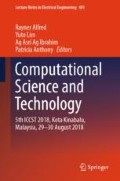Abstract
Autonomous spatial layout design had become the prominent applications for early planning process for a space arrangement. The available spatial layout design applications had focused on the structural and functional demands for a trendy, cultural influences and scalable spatial design. The previous research on the autonomous spatial layout design had proved that the Genetic Algorithm (GA) with full-fledged of operators are able to design an optimal spatial layout that is scalable for the space utilization. However, in these recent years, due to many occurrences of emergency incidents, the security assurance of the pedestrian to evacuate from the spatial layout during panic situation had become the main focus in designing a spatial layout. Hence, this research had proposed the pedestrian movement simulation using Cellular Automata (CA) with the Moore Neighborhood transition movement direction as the objective function for optimizing the GA operators based spatial layout design. The results have shown that the CA based pedestrian movement simulation was able to optimize the GA operators based spatial layout design in designing a feasible and scalable space arrangement with low-risk of pedestrian casualties.
Access this chapter
Tax calculation will be finalised at checkout
Purchases are for personal use only
Preview
Unable to display preview. Download preview PDF.
References
Bhatt, M., et al. Artificial Intelligence for Predictive and Evidence Based Architecture Design. in AAAI. 2016.
Indraprastha, A. and M. Shinozaki, Computational Models for Measuring Spatial Quality of Interior Design in Virtual Environment. Building and Environment, 2012. 49: p. 67-85.
Regateiro, F., J. Bento, and J. Dias, Floor Plan Design using Block Algebra and Constraint Satisfaction. Advanced Engineering Informatics, 2012. 26(2): p. 361-382.
Mustafa, F.A. and A.S. Hassan, Mosque Layout Design: An Analytical Study of Mosque Layouts in the Early Ottoman Period. Frontiers of Architectural Research, 2013. 2(4): p. 445-456.
Arnolds, I.V. and S. Nickel, Multi-Period Layout Planning for Hospital Wards. Socio-Economic Planning Sciences, 2013. 47(3): p. 220-237.
IKEA. IKEA Home Planner Tool. 2016; Available from: http://www.ikea.com/ms/en_US/rooms_ideas/splashplanners_new.html.
Planner5D. Home Design and Interior Decor in 2D & 3D. 2017; Available from: https://planner5d.com/.
RoomSketcher. RoomSketcher Home Designer. 2017; Available from: http://www.roomsketcher.com/.
Zhu, Y., Y. Zhu, and H. Liao. A study of spatial layout design of fishing vessels. in Computer-Aided Industrial Design & Conceptual Design, 2009. CAID & CD 2009. IEEE 10th International Conference on. 2009.
Hassan, F.H., et al., Incorporating Genetic Algorithm Operators in Optimization Spatial Layout Design, in Proceedings of the International Conference on Advances in Image Processing. 2017, ACM: Bangkok, Thailand. p. 179-183.
Huixian, J. and Z. Shaoping. Navigation system design of fire disaster evacuation path in buildings based on mobile terminals. in 2016 11th International Conference on Computer Science & Education (ICCSE). 2016.
Sime, J.D., Crowd psychology and engineering. Safety Science, 1995. 21(1): p. 1-14.
Kihlstrom, J.F., The person-situation interaction. The Oxford handbook of social cognition, 2013: p. 786-805.
Jay, B.N., Tahfiz did not have fire exit; bodies found piled on top of each other, in New Straits Times. 2017, New Straits Times Press (M) Berhad: Malaysia.
Four in a Family Killed in Fire, in The Star Online. 2017, Star Media Group Berhad (ROC 10894D).
Lu, X., et al., Impacts of Anxiety in Building Fire and Smoke Evacuation: Modeling and Validation. IEEE Robotics and Automation Letters, 2017. 2(1): p. 255-260.
Yamin, M., H.M. Al-Ahmadi, and A.A. Muhammad. Integrating social media and mobile apps into Hajj management. in 2016 3rd International Conference on Computing for Sustainable Global Development (INDIACom). 2016.
Michalek, J. and P. Papalambros, Interactive Design Optimization of Architectural Layouts. Engineering Optimization, 2002. 34(5): p. 485-501.
Hassan, F.H., S. Swift, and A. Tucker, Using Heuristic Search with Pedestrian Simulation Statistics to Find Feasible Spatial Layout Design Elements’. Journal of Algorithms, 2014. 2(4): p. 86-104.
Hassan, F.H. and A. Tucker, Automatic Layout Design Solution, in Advances in Intelligent Data Analysis X: 10th International Symposium, IDA 2011, Porto, Portugal, October 29-31, 2011. Proceedings, J. Gama, E. Bradley, and J. Hollmén, Editors. 2011, Springer Berlin Heidelberg: Berlin, Heidelberg. p. 198-209.
Hassan, F.H. and A. Tucker. Using Uniform Crossover to Refine Simulated Annealing Solutions for Automatic Design of Spatial Layouts. in IJCCI (ICEC). 2010.
Narahara, T. and K. Terzidis, Multiple-Constraint Genetic Algorithm in Housing Design. Synthetic Landscapes 25th ACADIA, 2006.
Renner, G. and A. Ekárt, Genetic Algorithms in Computer Aided Design. Computer-Aided Design, 2003. 35(8): p. 709-726.
Helbing, D., I. Farkas, and T. Vicsek, Simulating dynamical features of escape panic. Nature, 2000. 407(6803): p. 487-490.
Acknowledgement
Research experiment reported here is pursued under the Fundamental Research Grant Scheme (FRGS) by Ministry of Education Malaysia for “Enhancing Genetic Algorithm for Spatial Layout Design Optimization with Pedestrian Simulation in a Panic Situation” [203.PKOMP.6711534], Research University Grant (RUI) by Universiti Sains Malaysia for “Bio-Inspired Optimization Algorithm for Spatial Layout Design of Cul-de-sac Area using Microscopic Pedestrian Movement in a Panic Situation” [1001.PKOMP.8014073] and Bridging Grant by Universiti Sains Malaysia for “Pedestrian Simulation Model for Clogging Detection and Survival Prediction in a Fire Spreading Situation” [304.PKOMP.6316019]. The preliminary study of this research is supported under the Short Term Grant Scheme by Universiti Sains Malaysia for “Pedestrian Simulator and Heuristic Search Methods for Spatial Layout Design” [304.PKOMP.6313169].
Author information
Authors and Affiliations
Corresponding author
Editor information
Editors and Affiliations
Rights and permissions
Copyright information
© 2019 Springer Nature Singapore Pte Ltd.
About this paper
Cite this paper
Ibrahim, N., Hassan, F.H., Zakaria, S.A. (2019). Incorporating Cellular Automaton based Microscopic Pedestrian Simulation and Genetic Algorithm for Spatial Layout Design Optimization. In: Alfred, R., Lim, Y., Ibrahim, A., Anthony, P. (eds) Computational Science and Technology. Lecture Notes in Electrical Engineering, vol 481. Springer, Singapore. https://doi.org/10.1007/978-981-13-2622-6_28
Download citation
DOI: https://doi.org/10.1007/978-981-13-2622-6_28
Published:
Publisher Name: Springer, Singapore
Print ISBN: 978-981-13-2621-9
Online ISBN: 978-981-13-2622-6
eBook Packages: EngineeringEngineering (R0)

